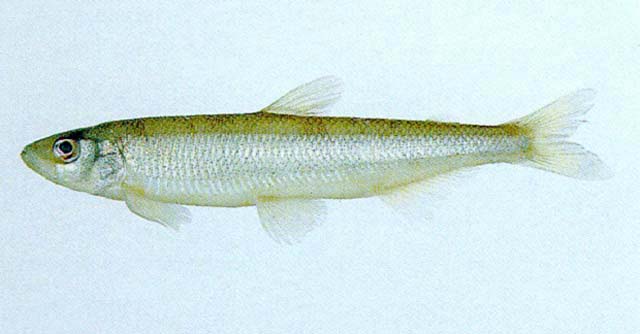| Osmeridae (Smelts) |
| 20 cm TL (male/unsexed); max.weight: 50.0 g; max. reported age: 10 years |
|
pelagic-neritic; freshwater; brackish; marine; depth range - 10 m, anadromous |
| Arctic, Northwest to Northeast Pacific: drainages from Rae River (Coronation Gulf) and Great Bear Lake in Northwest Territories, Canada to Copper River in Alaska (Ref. 33312). Also rivers, estuaries and coastal waters of European and Siberian shores of Artic Ocean, from Kara drainage to Chukotka in eastern Siberia and to Korea and Hokkaido in Japan (Ref. 59043). |
|
Dorsal spines (total): 0-0; Dorsal soft rays (total): 8-11; Anal spines: 0-0; Anal soft rays: 13-17; Vertebrae: 52-56. Vomer without posterior process; periphery of glossohyal bone with single row of conical teeth, another row of smaller teeth in center; pyloric caeca 2 (1-5); base of adipose fin more than 20% of head length; adipose eyelid absent. |
| Inhabits brackish water of estuaries, lagoons, coastal waters of open sea, freshwater of lowland and piedmont rivers and lakes (Ref. 59043). Found in the middle and surface waters of ponds, lakes, and streams over a variety of bottom types (Ref. 5723, 86798). The species is basically anadromous, ascending rivers to spawn in spring (Ref. 33312). The anadromous populations are pelagic at the sea, commonly at 4-5 m depth and spawn in rivers. Landlocked populations may spawn in lakes or undertake migration to their tributaries. Spawns along shallow river shores and in backwaters with little or no current, often in lakes, on sand or gravel bottom (Ref. 59043). Within a specific lake or pond, adults are generally found in inshore spawning areas in spring and early summer, later moving offshore (Ref. 27547). Feeds on zooplankton, insects and algae (Ref. 28680, 28681). Only a few survive beyond age 3 (Ref. 27547). |
|
Least Concern (LC); Date assessed: 16 February 2012 Ref. (130435)
|
| harmless |
Source and more info: www.fishbase.org. For personal, classroom, and other internal use only. Not for publication.
